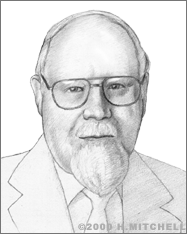Eskil Karlson
In his career of over 60 years, Eskil Karlson has produced about 100 inventions. His most impressive efforts have converted a poison into a purifier: ozone-based sterilization systems.
Eskil L. Karlson was born in Johnkoping, Sweden in 1920 and immigrated to the U.S. with his family at a young age. He felt somewhat alienated from his fellow students, but he was thoroughly at home in the sciences. By sixth grade, he was studying college textbooks. Meanwhile, Karlson built small-scale civil engineering projects in his backyard. He was granted the first of his nearly 100 patents for an acid-resistant glass bottle capping system that he created in his first year of high school.
Karlson majored in physics at the University of Pittsburgh, but he also took many courses in zoology at Pitt's Medical School, looking for bio-technological problems that needed solving. Karlson stayed on at Pitt to earn an MS in Biophysics. He later received his doctorate degree from Occidental St. Louis University.
After World War II, Karlson joined a Nevada nuclear test site as Head of Applied Physics. There, he not only managed atomic bomb tests, but also helped in the design of a novel nuclear rocket propulsion system, the "Kiwi A." Karlson's other nuclear work included a nuclear submarine power testing model, the first prototype digital scalers, transistorized portable survey meters, and neutron body equivalent counters.
In 1960, Karlson founded a company for the research and development of radiation detection, monitoring, and control systems. In 1967, Karlson worked with ozone (O3) for the first time. This infamous, poisonous gas would become Karlson's preferred medium. In fact, in 1972, Karlson wrote an article entitled, "Ozone: Friend or Foe?" – arguing, of course, for the former. In 1971, Karlson founded Life Support, Inc., an industrial design firm based in Erie, Pennsylvania whose leading products, such as Karlson's Continuous Ion Exchange System for pollution abatement and control (patented in 1976), would be ozone sterilizers.
Karlson never abandoned his interest in medical technology. He invented a radioisotope device to detect thyroid tumors as well as the predecessor to the modern heart canula. In 1974, Karlson patented what is considered to be the first implantable artificial heart. That same year, he was invited to South Africa by Dr. Christiaan Barnard, the surgeon who performed the first human heart transplant in 1967.
While visiting Africa, Karlson was struck by the severe and widespread lack of water purification systems among the country's indigent population. Karlson knew that ozone introduced to water will kill all organic materials present and will oxidize their remains to carbon dioxide, and that a few cities (Paris, for example) have used ozone in their municipal water systems for decades.
Throughout the 1980s, Karlson invented and patented many improved fluid treatment systems that use ozone to purify water. In the mid-1990s, Karlson's work came full circle, when he began inventing and patenting ozone sterilization devices for the medical field. A lot of medical equipment is too sensitive for high-temperature or high-pressure sterilization. Since the 1950s, the most common low-temperature sterilization agent has been ethylene oxide. This toxic, flammable, carcinogenic compound works slowly, evaporates even more slowly, and must be diluted with CFCs (which, ironically, threaten the earth's ozone layer).
For the underprivileged of Africa, India, and Southeast Asia, where the sick often die of dehydration for lack of clean, pyrogen-free water, Karlson invented a self-sterilizing, pyrogen-free water system.
Karlson passed away on February 17, 2005.


